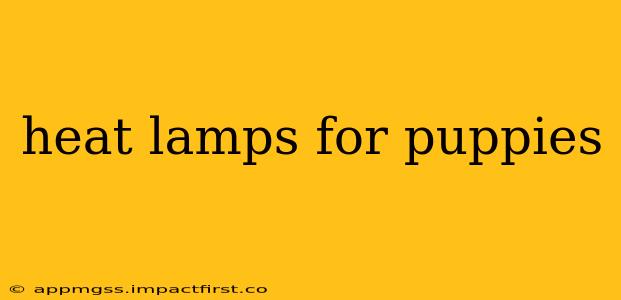Bringing home a new puppy is an exciting time, filled with playful moments and endless cuddles. However, ensuring your tiny bundle of joy stays warm and healthy is crucial, especially for very young puppies or those born in colder climates. Heat lamps can be a valuable tool in maintaining a comfortable environment, but it's crucial to understand their proper use to avoid potential dangers. This guide will delve into the specifics of using heat lamps for puppies, addressing common concerns and safety precautions.
Are Heat Lamps Necessary for Puppies?
This depends entirely on the puppy's age, breed, and environment. Very young puppies (under 4 weeks old) often lack the ability to regulate their body temperature effectively. Small breeds and those with thin coats are also more susceptible to hypothermia. If your puppy is shivering excessively, lethargic, or seems unusually cold, supplemental heat may be necessary. However, overheating is just as dangerous as hypothermia, so careful monitoring is paramount. A warm, draft-free environment is often sufficient, and a heat lamp should only be considered a supplemental heating source.
What Kind of Heat Lamp is Best for Puppies?
The ideal heat lamp for puppies is a red or infrared heat lamp. These emit heat without producing excessive visible light, which can disrupt your puppy's sleep cycle. Avoid using standard incandescent bulbs, as these produce significant heat and pose a higher fire risk. Look for lamps specifically designed for reptile or pet heating, as these are often more regulated for safety and efficiency. The wattage should be appropriate for the size of the area you're heating; a higher wattage lamp will heat a larger space more effectively.
How to Set Up a Heat Lamp for a Puppy?
- Proper Distance: The crucial element is distance. The heat lamp should never be directly above the puppy's sleeping area. Position it far enough away that the puppy can move away if it gets too warm. The ideal distance will depend on the wattage of the bulb, but a good rule of thumb is to allow the puppy to comfortably move between a warmer and cooler area.
- Safe Placement: Mount the lamp securely and high enough to prevent your puppy from reaching or chewing on the cord or the lamp itself. Use a sturdy clamp lamp or a stand specifically designed for heat lamps.
- Temperature Monitoring: Invest in a reliable thermometer to monitor the temperature in your puppy's sleeping area. The ideal temperature range is typically between 85-90°F (29-32°C) for newborn puppies and gradually decreasing as they age. Never exceed 95°F (35°C).
- Supervision: Always supervise your puppy when the heat lamp is on, particularly during the initial period of introduction.
How Long Should a Heat Lamp Be Used for Puppies?
The duration of heat lamp use varies greatly depending on your puppy's individual needs and age. It's generally recommended to use the heat lamp only when necessary, typically during colder nighttime hours or when the puppy exhibits signs of hypothermia. As your puppy grows and develops, it will become better at regulating its own body temperature, and the need for supplemental heat should diminish.
What are the Risks of Using a Heat Lamp for Puppies?
While heat lamps can be beneficial, they also present several risks:
- Burns: The most significant risk is burns. The lamp should always be placed at a safe distance and monitored regularly.
- Fire Hazards: Improper use can lead to fire hazards. Ensure the lamp is securely mounted, the cord is protected, and the bulb is the correct wattage for your fixture.
- Dehydration: Excessive heat can lead to dehydration. Ensure your puppy always has access to fresh, clean water.
- Overheating: Overheating is just as dangerous as hypothermia. Monitor the temperature closely and allow your puppy to regulate its own temperature.
My Puppy is Still Cold Even with a Heat Lamp, What Should I Do?
If your puppy remains cold despite using a heat lamp, consult your veterinarian immediately. There may be underlying health issues causing the coldness, such as hypoglycemia, infection, or other medical conditions.
Are there Alternatives to Heat Lamps for Keeping Puppies Warm?
Yes! There are several alternatives to consider:
- Warm bedding: Soft, plush bedding can provide additional warmth.
- Heating pads (low setting): These can provide gentle warmth, but always place them under a blanket to prevent direct contact and burns. Never use high heat settings.
- Warm water bottles (wrapped in towels): These provide a safe, gentler source of warmth.
- Creating a warm, draft-free environment: This is the most important aspect; a snug, insulated space with minimal drafts is key to keeping your puppy warm.
Using a heat lamp for your puppy can be a safe and effective way to ensure its comfort, but it's essential to prioritize safety and closely monitor your puppy's temperature and behavior. Always consult your veterinarian if you have any concerns about your puppy's warmth or overall health. Remember, a warm and nurturing environment is crucial for your puppy's healthy development.
